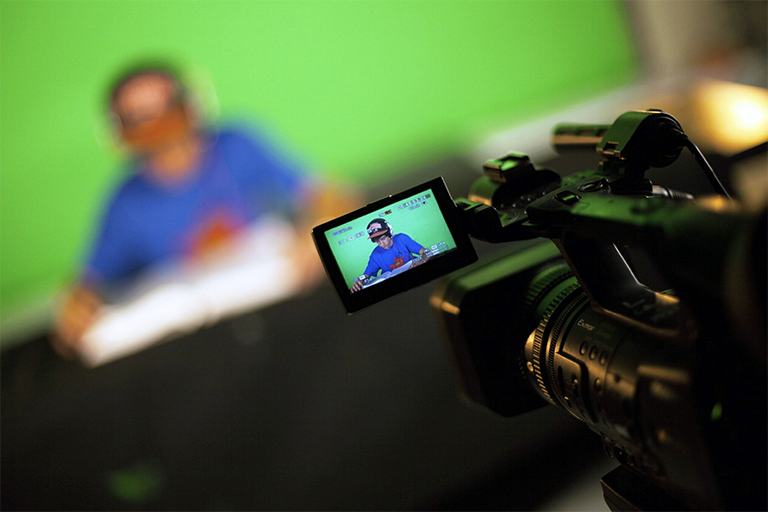Sandbox [sand-boks]
n. a box or receptacle for holding sand, especially one large enough for playing with creative ideas and amazing tools.
v. think, look, play, make, build, invent, experiment, connect, communicate, dream, imagine, etc.
Sandbox is all about mixing things up
Out there, beyond the rigid walls and halls of academia in that fast-paced, ever-changing "real world," life is all mixed up…it ain't tidy. Great creativity comes from great blending, and when a variety of skills, personalities, experiences, interests, ideas, knowledge and abilities are forced together and thrown at a challenging project or problem, the intense synergies that result will produce work that is explosively unique and highly effective.
Today’s media world provides several outlets and opportunities for projects that are driven by storytelling, artistic and expressive impulses. Our students and faculty create films, documentaries, websites, layouts, animations, games, television and radio projects that entertain and enlighten audiences of all ages.
At its core, Sandbox is a creative community and a media curriculum housed in the MSU College of Communication Arts and Sciences that tackles complex problems and expands experiences for students and faculty beyond the classroom, often to serve the greater good.
For example, our interdisciplinary Street Teams hit the streets to help others, like nonprofits with limited resources, in whatever ways the students' media and storytelling skills can, such as rebuilding a group's digital and print communications platforms. Sandbox is an integrated media program that teaches cinematic arts, journalism, advertising communications and game development, with additional skills in:
- Animation/Special FX
- Audio Production
- 3D Modeling
- Data Visualization/infographics
- Programming
- Graphic Design
- Illustration/Drawing
- Interactive Design
- Animation/Special FX
- Film/Video Production
- Web Design & Development
- Writing
What do we mean by "a creative community?"
At Sandbox, we embrace change, encourage innovation, inspire creativity and change the lives of everyone we work with.
Students work through the Sandbox to apply their creativity and talents towards real-world, cutting-edge media projects they work on with faculty and industry-professionals. At Sandbox, we also get students together and blow their minds wide open with events like speakers, field trips, activities and workshops.
As a creative community, we look at challenges from different perspectives in order to generate the kind of powerful ideas that make us more effective problem solvers and storytellers. We like to solve issues, whether its by helping nonprofits who work with underserved populations or by working with companies to tackle problems they're having internally.
Students use their skills and talents to tell compelling stories, and that's what we do best. Sandbox is an integrated program of cinematic arts, journalism, advertising and game development, with additional skills in graphic design, web design, app development, visual storytelling, 3D art and animation. Students work collaboratively across ComArtSci majors including Advertising + PR, Journalism, Media & Information and Communication to solve creative challenges.
We're here to shake things up, to get students and and faculty from across campus and across disciplines collaborating on all sorts of projects and activities.
History
A few ComArtSci professors from Advertising, Journalism and Media and Information began to realize, to their dismay, that there was little-to-no interaction between faculty and students in the different majors. People mostly knew their colleagues and friends in their own departments. But…
The world doesn't work that way; everything is all mixed together and integrated. For instance, journalism is supported by advertising, and students who shoot film and design games could get jobs in journalism and advertising fields. We began to realize that we needed to mix students from different majors into the same classrooms to study together.
There was a lot of class time being spent, typically at the 300-level, in the different departments teaching basic communication foundations. We realized that this core knowledge crossed majors, like the fundamentals of graphic design, shooting video and taking pictures, and that if we removed the time spent at the upper levels teaching these basics, the professors could spend more time on teaching higher level content, like how to design a complicated advertisement, writing and formatting a news layout, building an interactive website and more.
It was clear that if we moved this foundation knowledge into classes that students could take as soon as they stepped onto campus, they would experience four years learning their craft instead of roughly two. These early 100 and 200-level media classes also tapped into the passion students had for doing what they loved in high school, such as taking photos, making games or designing news materials.
Questions?
Contact sandbox@msu.edu to get involved.
